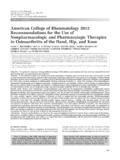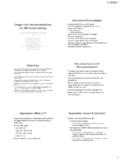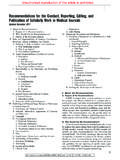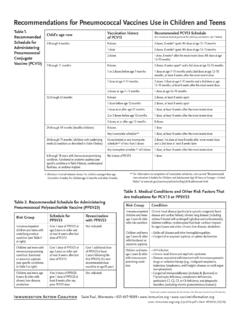Transcription of WHO recommendations on the use of rapid testing for ...
1 WHO recommendations on the use of rapid testing for influenza diagnosis 1. General information Influenza outbreaks and epidemics pose ongoing risks to global human public health. Recently, human infections with A/H5N1 avian influenza viruses have heightened the potential for the emergence of an influenza A virus with pandemic potential. In response, the World Health Organization (WHO) is working to strengthen influenza surveillance ( ) and increase laboratory capacity for the diagnosis of influenza and the early detection of emerging pandemic strains. Laboratory identification of human influenza virus infections is commonly performed using direct antigen detection, virus isolation in cell culture, or detection of influenza-specific RNA by reverse transcriptase-polymerase chain reaction (RT-PCR).
2 In recent years commercial influenza rapid diagnostic tests have become available. These are mostly antigen detection tests, which can produce results within 30 minutes. They can provide results in a clinically relevant time frame to complement the use of antiviral medications for treatment and chemoprophylaxis of influenza. Their wide availability has resulted in their increasing application to clinical situations, which may be inappropriate or where scientific data are lacking. recommendations in this document are intended for laboratories receiving requests to test specimens from patients with suspected influenza, in situations where influenza surveillance may or may not be active, and in countries where there may be evidence of infrequent human infections by avian influenza viruses.
3 They are intended to complement the Recommended laboratory tests to identify avian influenza A virus in specimens from humans ( ). 2. rapid diagnostic tests for influenza Commercially available rapid diagnostic tests are screening tests for influenza A and B virus infections, which can provide results within 30 minutes. These tests are largely immunoassays which detect influenza viral antigen, while one test detects viral neuraminidase activity. They may also be referred to as near patient or point-of-care tests. Tests either detect and distinguish between influenza A and influenza B infections, detect but do not distinguish between influenza A and B or detect influenza A only. They vary in their complexity, the type of respiratory specimens acceptable for testing and the time needed to produce results.
4 A list of these tests is included in Annex1. WHO recommendations on the use of rapid testing for influenza diagnosis July 2005 2 Acceptable respiratory specimens Most tests can be used on a variety of respiratory specimen types, however not all specimen types yield equivalent results, and other factors can influence specimen quality. Nasal aspirates, nasal washes, sputa and nasopharyngeal swabs, especially those specimens containing cellular material, are preferable to nasal swabs and throat swabs. They should be collected as close to the onset of symptoms as possible and not after 4 5 days in adults as virus shedding typically diminishes. In young children, viral shedding may occur for longer periods, and the collection of specimens for testing after 5 days of illness may still be useful.
5 There are very limited data on the shedding of avian influenza viruses in human infections. For guidelines on human specimen collection and handling see WHO guidelines for the collection of human specimens for laboratory diagnosis of avian influenza infection ( ). Influenza A and B reactivity All rapid tests have been demonstrated to have reactivity with a range of recent human influenza A and B strains. These tests detect a common antigen of all influenza A viruses or B viruses; however, rapid tests cannot distinguish between influenza A subtypes. Some manufacturers have evaluated their test kits for reactivity with some animal influenza viruses. No study has been performed to assess the accuracy of rapid tests to detect human infection with avian influenza viruses.
6 Test complexity rapid tests vary in complexity with the number of steps required to perform each test ranging from 2 8. The United States is currently the only country to categorize their complexity. The rapid diagnostic tests, which are easy to use and interpret, are waived from approval by the Food and Drug Administration, for use in a clinical/office setting, while others are classified as moderately complex and must be used in a diagnostic laboratory setting. Other countries may require specific agency approval for rapid test use. Training in the use of rapid diagnostic tests is highly recommended because of their varying complexity and the importance of specimen type and quality (Thomas Y et al, 2003).
7 Clinical accuracy The accuracy of an influenza diagnostic test is determined by the sensitivity and specificity of the test to detect an influenza virus infection compared with a gold standard (usually culture) and the prevalence of influenza in the community (Uyeki TM, 2003). Sensitivity is the percentage of true influenza cases detected as positive by a test. Specificity is the percentage of true non-influenza cases detected as being negative by a test. Positive predictive value (PPV) of a test is the percentage of test positive cases that have influenza. Negative predictive value (NPV) is the percentage of test negative cases that do not have influenza. In general, the sensitivity of rapid tests is variable (median 70 75%) and lower than that of cell culture, while their specificity is high (median 90 95%).
8 Because of the low sensitivity, false negative results are a major concern with these tests. WHO recommendations on the use of rapid testing for influenza diagnosis July 2005 3 Unlike sensitivity and specificity, the PPV and NPV are affected by disease prevalence. Thus, an influenza rapid test will have: During peak influenza activity: the highest PPV with positive results more likely to be true and lowest NPV, with false-negative results more likely. During low influenza activity: the lowest PPV with false-positive tests more likely, and highest NPV, with negative results more likely to be true. Accuracy of clinical diagnosis and other laboratory tests Clinical diagnosis: The positive predictive value of any adult influenza case definition has ranged from 18 87% compared with laboratory confirmed influenza.
9 During periods of influenza prevalence, clinical diagnosis (based on the acute onset of high fever and cough) can be highly predictive of influenza (PPV 79 87%; NPV 39 75%). The probability of a patient having confirmed influenza increases with increasing fever and acute presentation (within 36 48 hours of onset) (Gavin PJ, Thomson ). Immunofluorescent antibody staining: The sensitivity of influenza antigen detection in respiratory specimens by immunofluorescent staining in comparison to cell culture ranges between 70 100%; specificity, 80 100%; PPV, 85 94%; NPV, 96 100%. Viral culture: Considered the gold standard . Polymerase chain reaction: RT-PCR assays detect both viable and non-viable influenza virus RNA and are in general more sensitive than culture.
10 Improved detection rates over culture may be between 2 13%. 3. The role of rapid tests for influenza: clinical considerations Influenza is associated with high morbidity and mortality, is preventable by vaccination and chemoprophylaxis and is treatable by specific antivirals. In general, rapid diagnostic testing for influenza should be carried out when the results will influence a clinical decision. Patient management: The laboratory diagnosis of influenza can help guide the clinical management of influenza patients in a hospital or other health care setting. Patients with lower respiratory tract illness, especially children and adults with medical conditions increasing their risk for developing complicated influenza, should be considered for rapid influenza virus diagnostic testing during their outpatient triage.


















